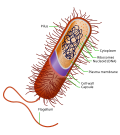A prokaryote (/proʊˈkærioʊt, -ət/; less commonly spelled procaryote) is a single-cell organism whose cell lacks a nucleus and other membrane-bound organelles...
44 KB (4,782 words) - 15:12, 18 November 2024
wall Capsule Pili Marine prokaryotes are marine bacteria and marine archaea. They are defined by their habitat as prokaryotes that live in marine environments...
136 KB (12,705 words) - 16:07, 22 October 2024
Nutrition (section Prokaryote)
unavailable. Prokaryotes, including bacteria and archaea, vary greatly in how they obtain nutrients across nutritional groups. Prokaryotes can only transport...
36 KB (4,032 words) - 22:56, 10 November 2024
They constitute a major group of life forms alongside the two groups of prokaryotes: the Bacteria and the Archaea. Eukaryotes represent a small minority...
61 KB (6,102 words) - 20:36, 17 November 2024
prokaryotic cells, which lack a nucleus but have a nucleoid region. Prokaryotes are single-celled organisms such as bacteria, whereas eukaryotes can...
60 KB (6,271 words) - 04:42, 20 August 2024
The International Code of Nomenclature of Prokaryotes (ICNP) or Prokaryotic Code, formerly the International Code of Nomenclature of Bacteria (ICNB) or...
11 KB (1,300 words) - 17:02, 20 October 2024
animals (including protists), plants (also including algae and fungi) and prokaryotes (bacteria and archaea), is Latin and binomial in form; this contrasts...
27 KB (3,130 words) - 01:27, 17 November 2024
Circular chromosome (redirect from Circular prokaryote chromosome)
of circular DNA, unlike the linear chromosome of most eukaryotes. Most prokaryote chromosomes contain a circular DNA molecule. This has the major advantage...
21 KB (2,745 words) - 08:39, 17 November 2024
Extremophile (redirect from Extremophilic prokaryotes)
An extremophile (from Latin extremus 'extreme' and Ancient Greek φιλία (philía) 'love') is an organism that is able to live (or in some cases thrive) in...
62 KB (6,491 words) - 23:49, 11 November 2024
Prokaryotic cytoskeleton (redirect from Prokaryote cytoskeleton)
cytoskeleton is the collective name for all structural filaments in prokaryotes. It was once thought that prokaryotic cells did not possess cytoskeletons...
21 KB (2,508 words) - 01:13, 23 July 2024
In prokaryote nomenclature, Candidatus (abbreviated Ca.; Latin for "candidate of Roman office") is used to name prokaryotic taxa that are well characterized...
15 KB (1,749 words) - 04:35, 5 October 2024
traditionally included all prokaryotes, the scientific classification changed after the discovery in the 1990s that prokaryotes consist of two very different...
143 KB (15,534 words) - 20:00, 8 November 2024
Pan-genome (section Prokaryote pangenome)
elements that are shaped by selection and drift. Some studies point that prokaryotes pangenomes are the result of adaptive, not neutral evolution that confer...
51 KB (5,397 words) - 20:02, 17 October 2024
Phototroph (redirect from Phototrophic prokaryotes)
Phototrophs (from Ancient Greek φῶς, φωτός (phôs, phōtós) 'light' and τροφή (trophḗ) 'nourishment') are organisms that carry out photon capture to produce...
8 KB (740 words) - 06:42, 16 August 2024
on protists, and Ruggiero et al., 2015, covering both eukaryotes and prokaryotes to the rank of Order, although both exclude fossil representatives. A...
69 KB (6,803 words) - 00:22, 21 October 2024
Unicellular organism (section Prokaryotes)
general categories: prokaryotic organisms and eukaryotic organisms. Most prokaryotes are unicellular and are classified into bacteria and archaea. Many eukaryotes...
33 KB (3,362 words) - 17:15, 13 November 2024
(mostly in eukaryotes), or aspartic acid or histidine residues (mostly in prokaryotes). The phosphorylation of proteins is a major regulatory mechanism in...
2 KB (124 words) - 17:31, 22 October 2023
Fission (biology) (section Fission of prokaryotes)
Binary fission in a prokaryote...
20 KB (2,184 words) - 00:26, 10 November 2024
Chromosome (section Prokaryotes)
origins. The genes in prokaryotes are often organized in operons, and do not usually contain introns, unlike eukaryotes. Prokaryotes do not possess nuclei...
63 KB (6,554 words) - 11:15, 15 November 2024
Ribosomal RNA (section In prokaryotes)
60% rRNA and 40% ribosomal proteins, though this ratio differs between prokaryotes and eukaryotes. Although the primary structure of rRNA sequences can...
60 KB (7,203 words) - 11:15, 18 November 2024
antibiotics. A possible transitional form of microorganism between a prokaryote and a eukaryote was discovered in 2012 by Japanese scientists. Parakaryon...
74 KB (7,752 words) - 01:23, 14 November 2024
the dinoflagellate protists. He first coined the terms "eukaryote" and "prokaryote" in a 1925 paper, but did not elaborate on the concept; Roger Stanier...
4 KB (305 words) - 23:29, 22 August 2024
"solitary") is historically a biological kingdom that is made up of prokaryotes. As such, it is composed of single-celled organisms that lack a nucleus...
22 KB (2,698 words) - 10:50, 25 October 2024
Bacterial transcription (redirect from Transcription in prokaryotes)
Bacterial transcription is the process in which a segment of bacterial DNA is copied into a newly synthesized strand of messenger RNA (mRNA) with use of...
21 KB (2,369 words) - 18:35, 3 October 2024
divided into several different kingdoms. Originally his split of the prokaryotes was into Eubacteria (now Bacteria) and Archaebacteria (now Archaea)....
15 KB (1,601 words) - 10:54, 16 November 2024
prokaryotes. The set of chromosomes in a cell is collectively known as its genome. In eukaryotes, DNA is mainly in the cell nucleus. In prokaryotes,...
133 KB (13,837 words) - 17:58, 9 November 2024
Gene structure (section Prokaryotes)
long. Much of gene structure is broadly similar between eukaryotes and prokaryotes. These common elements largely result from the shared ancestry of cellular...
19 KB (2,320 words) - 19:26, 6 November 2024
Enzyme Eukaryote Fermentation Metabolism Meiosis Mitosis Photosynthesis Prokaryote Genetics DNA Epigenetics Evolutionary developmental biology Gene expression...
82 KB (9,873 words) - 17:58, 31 October 2024
asexually, as in single-celled organisms such as bacteria and other prokaryotes, and parthenogenetic or apomictic multi-celled organisms. DNA barcoding...
103 KB (10,535 words) - 14:59, 5 November 2024
Cell physiology (section Prokaryotes)
structure.[page needed] There are two types of cells: prokaryotes and eukaryotes. Prokaryotes were the first of the two to develop and do not have a...
8 KB (857 words) - 01:24, 19 October 2024






















